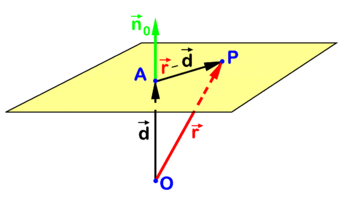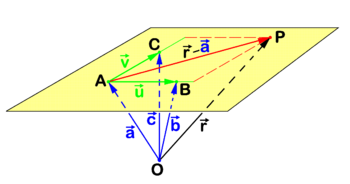User talk:Paul Wormer/scratchbook1: Difference between revisions
imported>Paul Wormer No edit summary |
imported>Paul Wormer No edit summary |
||
| Line 1: | Line 1: | ||
{{Image|Param1 plane.png|right|350px|<small>Equation for plane. ''X'' is arbitary point in plane; <font style<nowiki>=</nowiki> "vertical-align: text-top;"> <math>\scriptstyle\vec{\mathbf{a}}</math></font> and <font style<nowiki>=</nowiki> "vertical-align: text-top;"> <math>\scriptstyle\hat{\mathbf{n}} </math></font> are collinear.</small>}} | ===Point-normal representation=== | ||
In [[analytic geometry]] several closely related algebraic equations are known for a plane in three-dimensional Euclidean space. One such equation is illustrated in | {{Image|Param1 plane.png|right|350px|<small>Fig. 1. Equation for plane. ''X'' is arbitary point in plane; <font style<nowiki>=</nowiki> "vertical-align: text-top;"> <math>\scriptstyle\vec{\mathbf{a}}</math></font> and <font style<nowiki>=</nowiki> "vertical-align: text-top;"> <math>\scriptstyle\hat{\mathbf{n}} </math></font> are collinear.</small>}} | ||
In [[analytic geometry]] several closely related algebraic equations are known for a plane in three-dimensional Euclidean space. One such equation is illustrated in figure 1. Point ''P'' is an arbitrary point in the plane and ''O'' (the origin) is outside the plane. The point ''A'' in the plane is chosen such that vector | |||
:<math> | :<math> | ||
\vec{d} \equiv \overrightarrow{OA} | \vec{d} \equiv \overrightarrow{OA} | ||
| Line 8: | Line 9: | ||
\vec{n}_0 \equiv \frac{1}{d} \vec{d} \quad \hbox{with}\quad d \equiv \left|\vec{d}\,\right| | \vec{n}_0 \equiv \frac{1}{d} \vec{d} \quad \hbox{with}\quad d \equiv \left|\vec{d}\,\right| | ||
</math> | </math> | ||
is a unit (length 1) vector normal (perpendicular) to the plane. | is a unit (length 1) vector normal (perpendicular) to the plane which is known as the ''normal of the plane in point A''. Note that ''d'' is the distance of ''O'' to the plane. The following relation holds for an arbitrary point ''P'' in the plane | ||
:<math> | :<math> | ||
\left(\vec{r}-\vec{d}\;\right)\cdot \vec{n}_0 = 0 \quad\hbox{with}\quad \vec{r} \equiv\overrightarrow{OP}\quad\hbox{and}\quad \vec{r}-\vec{d} = \overrightarrow{AP} . | \left(\vec{r}-\vec{d}\;\right)\cdot \vec{n}_0 = 0 \quad\hbox{with}\quad \vec{r} \equiv\overrightarrow{OP}\quad\hbox{and}\quad \vec{r}-\vec{d} = \overrightarrow{AP} . | ||
| Line 54: | Line 55: | ||
</math> | </math> | ||
which is the equation for a plane through a point ''A'' perpendicular to <font style="vertical-align: super;"><math>\overrightarrow{OA}</math></font>. | which is the equation for a plane through a point ''A'' perpendicular to <font style="vertical-align: super;"><math>\overrightarrow{OA}</math></font>. | ||
===Three point representation=== | |||
{{Image|Param2 plane.png|right|350px|<small> Fig. 2. Plane through points ''A'', ''B'', and ''C''.}} | |||
Figure 2 shows a plane that by definition passes through the points ''A'', ''B'', and ''C''. The point ''P'' is an arbitrary point in the plane and the reference point ''O'' is not in the plane. Referring to figure 2 we introduce the following definitions | |||
:<math> | |||
\vec{a} = \overrightarrow{OA},\quad \vec{b} = \overrightarrow{OB},\quad\vec{c} = \overrightarrow{OC},\quad \vec{r} = \overrightarrow{OP}. | |||
</math> | |||
Clearly the following two non-collinear vectors belong to the plane | |||
:<math> | |||
\vec{u} = \overrightarrow{AB}= \vec{b}-\vec{a} ,\quad \vec{v} = \overrightarrow{AC}= \vec{c}-\vec{a}. | |||
</math> | |||
Any vector in the plane can be written as a linear combination of these two vectors. In particular, | |||
:<math> | |||
\overrightarrow{AP}= \vec{r}-\vec{a} = \lambda \vec{u} + \mu\vec{v}. | |||
</math> | |||
The real numbers λ and μ specify the direction of <font style="vertical-align: super;"><math>\overrightarrow{AP}</math><font>. Hence the equation for the position vector <font style="vertical-align: super;"><math>\vec{r}</math><font> of the arbitrary point ''P'' in the plane | |||
:<math> | |||
\vec{r} = \vec{a} + \lambda \vec{u} + \mu\vec{v} | |||
</math> | |||
is known as the ''point-direction representation'' of the plane. This representation is equal to the ''three-point representation'' | |||
:<math> | |||
\vec{r} = \vec{a}+ \lambda (\vec{b}-\vec{a}) + \mu(\vec{c}-\vec{a}) | |||
</math> | |||
Revision as of 07:51, 31 March 2010
Point-normal representation
In analytic geometry several closely related algebraic equations are known for a plane in three-dimensional Euclidean space. One such equation is illustrated in figure 1. Point P is an arbitrary point in the plane and O (the origin) is outside the plane. The point A in the plane is chosen such that vector
is orthogonal to the plane. The collinear vector
is a unit (length 1) vector normal (perpendicular) to the plane which is known as the normal of the plane in point A. Note that d is the distance of O to the plane. The following relation holds for an arbitrary point P in the plane
This equation for the plane can be rewritten in terms of coordinates with respect to a Cartesian frame with origin in O. Dropping arrows for component vectors (real triplets) that are written bold, we find
with
and
Conversely, given the following equation for a plane
it is easy to derive the same equation. Write
It follows that
Hence we find the same equation,
where f , d, and n0 are collinear. The equation may also be written in the following mnemonically convenient form
which is the equation for a plane through a point A perpendicular to .
Three point representation
Figure 2 shows a plane that by definition passes through the points A, B, and C. The point P is an arbitrary point in the plane and the reference point O is not in the plane. Referring to figure 2 we introduce the following definitions
Clearly the following two non-collinear vectors belong to the plane
Any vector in the plane can be written as a linear combination of these two vectors. In particular,
The real numbers λ and μ specify the direction of . Hence the equation for the position vector of the arbitrary point P in the plane
is known as the point-direction representation of the plane. This representation is equal to the three-point representation






















